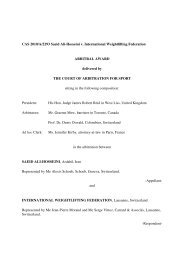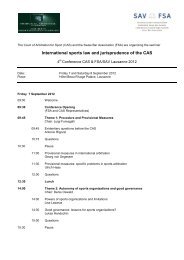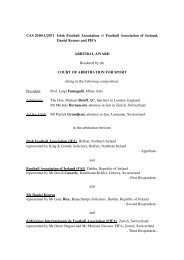(CAS) Bulletin - Tribunal Arbitral du Sport / TAS
(CAS) Bulletin - Tribunal Arbitral du Sport / TAS
(CAS) Bulletin - Tribunal Arbitral du Sport / TAS
You also want an ePaper? Increase the reach of your titles
YUMPU automatically turns print PDFs into web optimized ePapers that Google loves.
clenbuterol can only have entered the Athlete’s system<br />
by one of these three routes of ingestion. The Panel’s<br />
task is to make a decision as to which of those three is<br />
the most likely to have caused the positive test. That<br />
comparative exercise may bring the decision-maker<br />
to a conclusion which had it been measured ex ante,<br />
might have been thought improbable.<br />
Finally, to the extent that there is any disagreement<br />
or ambiguity as to the application of the balance of<br />
probability, the principle of contra preferentem applies,<br />
such that the construction to be preferred is the one<br />
that favours the Athlete.<br />
There is a further relevant aspect regarding the<br />
way in which the common law standard of balance<br />
of probability operates. That is the concept of the<br />
“evidential ” as opposed to the “l egal ” burden. Where<br />
a party has a legal burden, it may of course satisfy that<br />
burden in a range of ways. At one extreme the party<br />
may only just satisfy the burden; at the other extreme<br />
the hypothesis advanced may be shown to be nearly<br />
certainly correct. In seeking to discharge the burden,<br />
the party comes to a point, in a sense a “tipping point ”,<br />
where the material that the party has put forward in<br />
support of the hypothesis advanced would, without<br />
more, be suffi cient to convince the decision maker<br />
that the hypothesis was correct. The “legal ” burden<br />
would be discharged. At that point, the other party<br />
shoulders an “evidential ”, or practical, burden: it must<br />
ad<strong>du</strong>ce contrary evidence that suffi ciently contradicts<br />
the hypothesis advanced to tip the balance back, or<br />
lose the case on the evidence. That is, of course, what<br />
the Appellants have set out to do in fi rst criticising the<br />
hypothesis advanced by the Athlete that the source<br />
was contaminated meat, and secondly advancing the<br />
alternative hypothesis that a contaminated plasma<br />
transfusion was the cause, together with their fallback<br />
position, that a contaminated supplement might<br />
have been the cause.<br />
It is not suffi cient for the Appellants simply to<br />
raise an alternative scenario, uncorroborated, and<br />
then to say that the Athlete must disprove it; doing<br />
so amounts to no more than mere speculation. If<br />
the Appellants’ objective, as it appears to be, is to<br />
contradict the Athlete’s alleged more likely scenario<br />
to a degree that tips the evidence back in their favour,<br />
they must present suffi cient proof; and in assessing<br />
whether they have done this, two things need to be<br />
borne in mind:<br />
a) The normal standard imposed on regulatory<br />
authorities at the outset is of course “comfortable<br />
satisfaction”. Further, it is that standard that<br />
applies where a burden has shifted from the<br />
athlete back onto the regulatory authority. On<br />
no basis, therefore, would it be suffi cient for the<br />
regulatory authorities simply to raise speculative<br />
alternatives.<br />
b) When an athlete is seeking to establish the source<br />
of a substance on the balance of probabilities,<br />
<strong>CAS</strong> panels have accepted submissions from the<br />
authorities to the effect that a mere speculation as<br />
to a source is insuffi cient (see <strong>CAS</strong> 2006/A/1130<br />
and <strong>CAS</strong> 2007/A/1413). The principle of equal<br />
treatment requires authorities to be held to the<br />
same high standards. So here, for example, when<br />
the Appellants speculate without any evidence<br />
whatsoever that the source may have been a<br />
contaminated supplement, <strong>CAS</strong> must remember<br />
the scepticism with which it would regard a<br />
similar argument coming from an athlete.<br />
3.4 RFEC<br />
The RFEC alleges that the UCI and WADA in<br />
their appeal briefs state that the burden of proof is<br />
on Mr Contador, and that it is not met by indicating<br />
the most likely route of ingestion, since the Athlete<br />
must demonstrate that this route of ingestion is more<br />
likely to have occurred than not to have occurred;<br />
the RFEC ends this argument with the following<br />
assertion, “ Indeed the circumstance that a possibility is more<br />
likely than other possibilities does not mean that this relatively<br />
more likely possibility is also more likely to have occurred than<br />
not to have occurred ”.<br />
According to Article 296 UCI ADR and the<br />
arguments made by both the UCI and WADA, the<br />
Athlete is required to prove in this case, not only<br />
that he ate meat as the most likely possibility of the<br />
presence of clenbuterol in his bodily samples, but also<br />
that it contained clenbuterol (and that this substance<br />
is also the one that appeared in the adverse analytical<br />
fi nding) so there is a direct relation between the<br />
presence of the substance in his bodily sample and<br />
the one that, in turn, had been fed to the animal<br />
which meat was eaten by the Athlete, something<br />
which is quite impossible, since the single piece of<br />
evidence has disappeared, i.e. the meat. Ad<strong>du</strong>cing<br />
this particular element of evidence, obviously, is<br />
impossible for the Athlete and, if it is unfeasible,<br />
cannot be demanded by international organisations<br />
of Mr Contador or of other athletes. Otherwise, not<br />
only is the “onus probando” reversed but in many cases<br />
the proof becomes a “probatio diabolica”, <strong>du</strong>e to having<br />
to prove the non-existence of alleged acts.<br />
Therefore, it is necessary to make an appropriate<br />
and prudent interpretation and application of<br />
the provisions set forth in Article 22 UCI ADR,<br />
accounting for both science and the law when<br />
Jurisprudence majeure / Leading cases<br />
-<br />
114





